Strategic Management of H&M
VerifiedAdded on 2023/01/04
|13
|3466
|60
AI Summary
This report discusses the strategic management of H&M, including the external and internal analysis, strategic options for future direction, and critical evaluation of selected business strategy for growth.
Contribute Materials
Your contribution can guide someone’s learning journey. Share your
documents today.
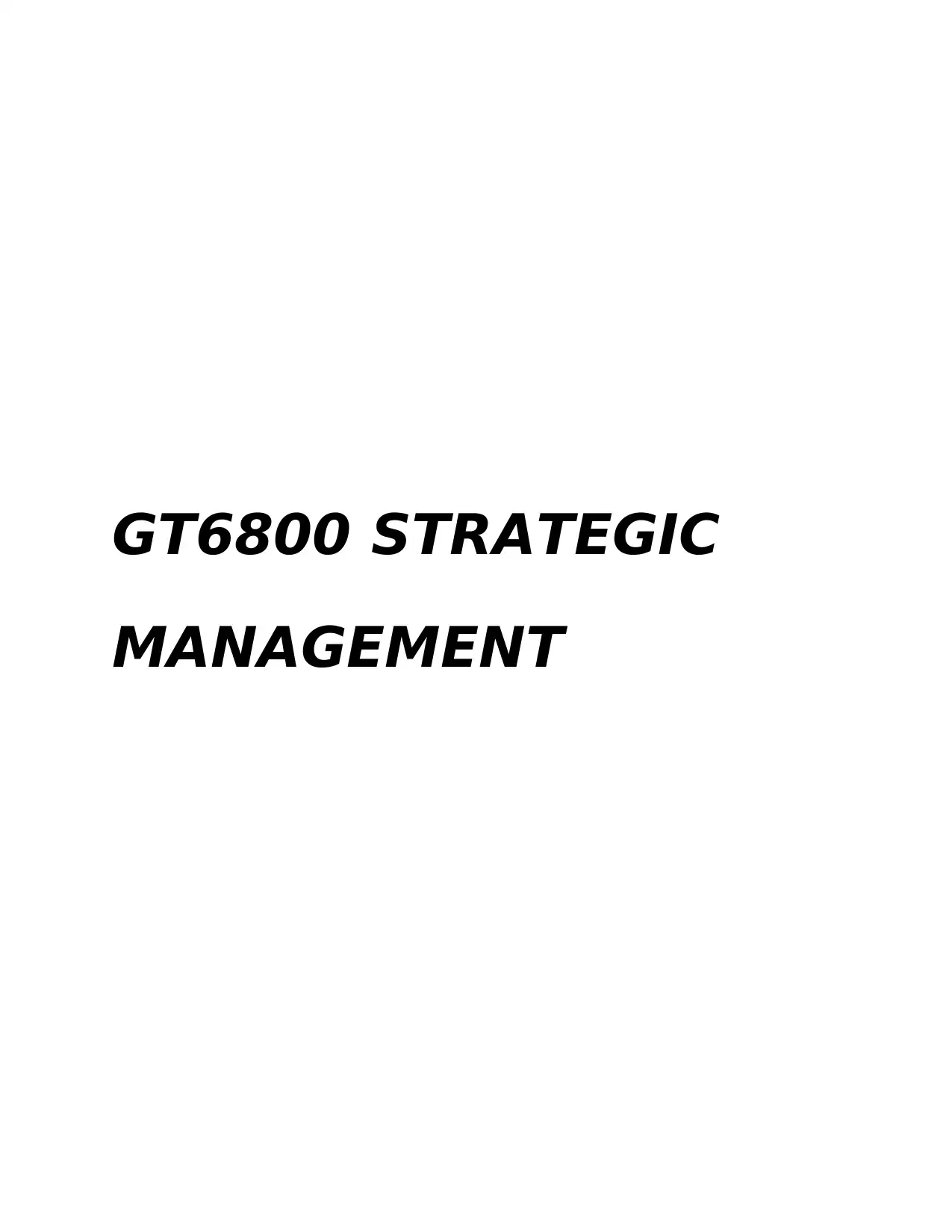
GT6800 STRATEGIC
MANAGEMENT
MANAGEMENT
Secure Best Marks with AI Grader
Need help grading? Try our AI Grader for instant feedback on your assignments.
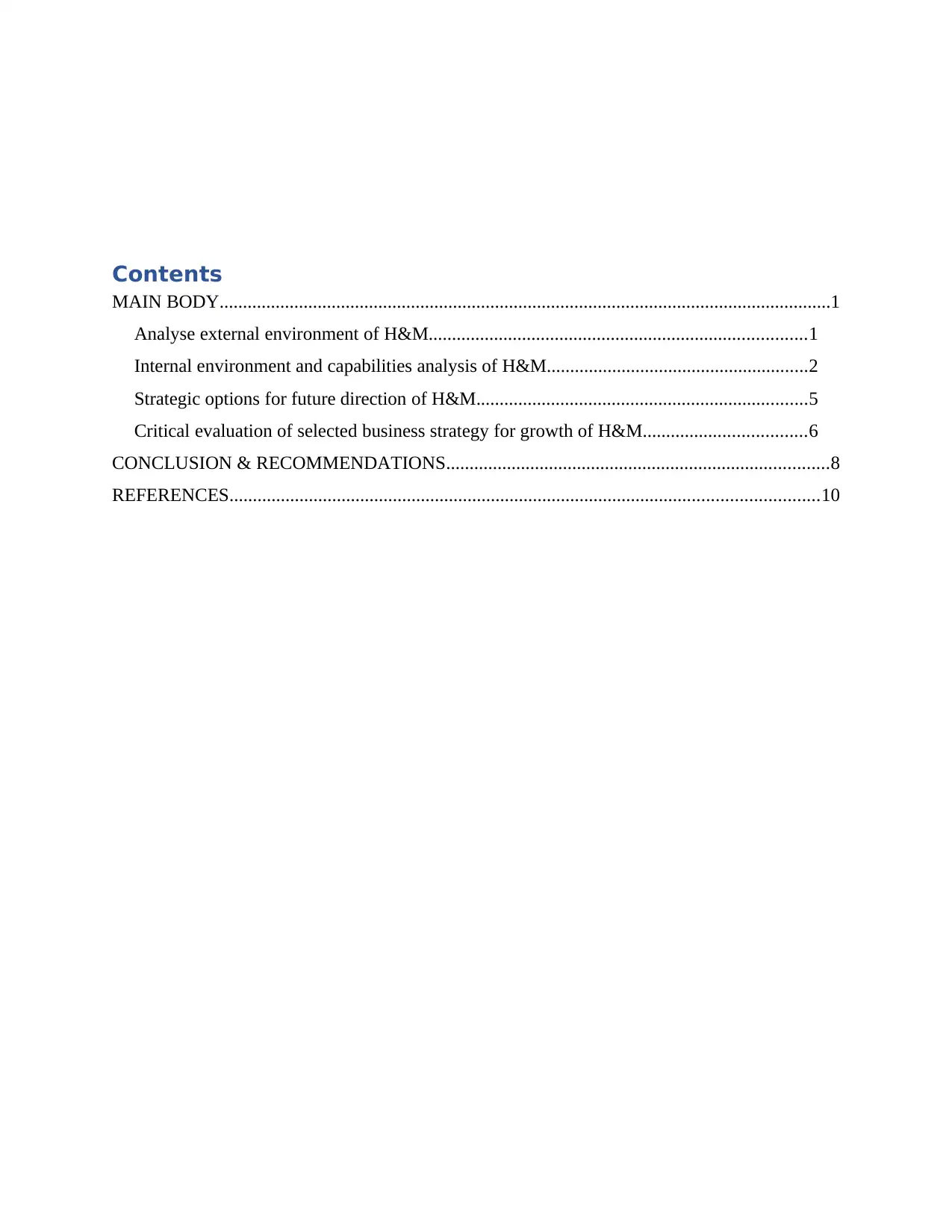
Contents
MAIN BODY...................................................................................................................................1
Analyse external environment of H&M.................................................................................1
Internal environment and capabilities analysis of H&M........................................................2
Strategic options for future direction of H&M.......................................................................5
Critical evaluation of selected business strategy for growth of H&M...................................6
CONCLUSION & RECOMMENDATIONS..................................................................................8
REFERENCES..............................................................................................................................10
MAIN BODY...................................................................................................................................1
Analyse external environment of H&M.................................................................................1
Internal environment and capabilities analysis of H&M........................................................2
Strategic options for future direction of H&M.......................................................................5
Critical evaluation of selected business strategy for growth of H&M...................................6
CONCLUSION & RECOMMENDATIONS..................................................................................8
REFERENCES..............................................................................................................................10
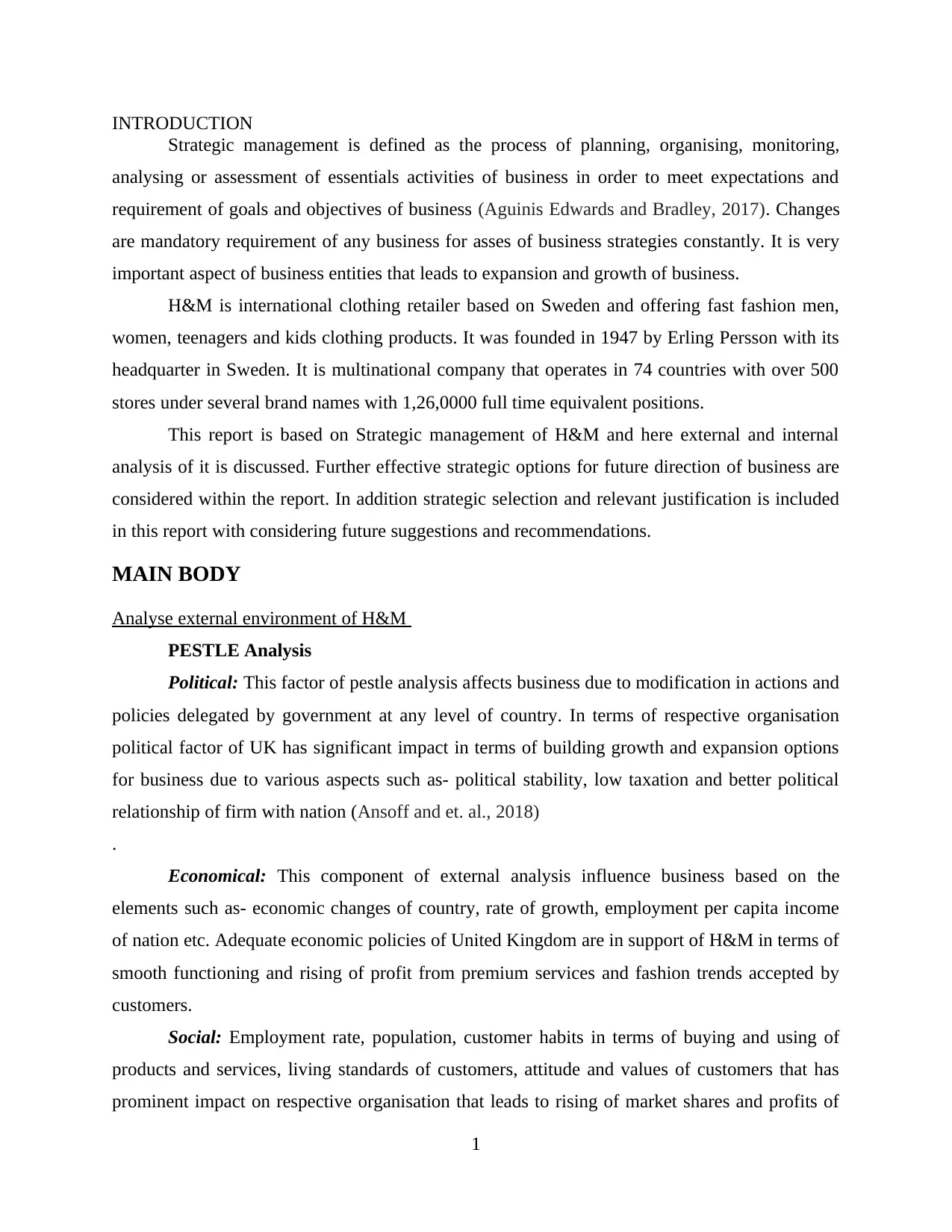
INTRODUCTION
Strategic management is defined as the process of planning, organising, monitoring,
analysing or assessment of essentials activities of business in order to meet expectations and
requirement of goals and objectives of business (Aguinis Edwards and Bradley, 2017). Changes
are mandatory requirement of any business for asses of business strategies constantly. It is very
important aspect of business entities that leads to expansion and growth of business.
H&M is international clothing retailer based on Sweden and offering fast fashion men,
women, teenagers and kids clothing products. It was founded in 1947 by Erling Persson with its
headquarter in Sweden. It is multinational company that operates in 74 countries with over 500
stores under several brand names with 1,26,0000 full time equivalent positions.
This report is based on Strategic management of H&M and here external and internal
analysis of it is discussed. Further effective strategic options for future direction of business are
considered within the report. In addition strategic selection and relevant justification is included
in this report with considering future suggestions and recommendations.
MAIN BODY
Analyse external environment of H&M
PESTLE Analysis
Political: This factor of pestle analysis affects business due to modification in actions and
policies delegated by government at any level of country. In terms of respective organisation
political factor of UK has significant impact in terms of building growth and expansion options
for business due to various aspects such as- political stability, low taxation and better political
relationship of firm with nation (Ansoff and et. al., 2018)
.
Economical: This component of external analysis influence business based on the
elements such as- economic changes of country, rate of growth, employment per capita income
of nation etc. Adequate economic policies of United Kingdom are in support of H&M in terms of
smooth functioning and rising of profit from premium services and fashion trends accepted by
customers.
Social: Employment rate, population, customer habits in terms of buying and using of
products and services, living standards of customers, attitude and values of customers that has
prominent impact on respective organisation that leads to rising of market shares and profits of
1
Strategic management is defined as the process of planning, organising, monitoring,
analysing or assessment of essentials activities of business in order to meet expectations and
requirement of goals and objectives of business (Aguinis Edwards and Bradley, 2017). Changes
are mandatory requirement of any business for asses of business strategies constantly. It is very
important aspect of business entities that leads to expansion and growth of business.
H&M is international clothing retailer based on Sweden and offering fast fashion men,
women, teenagers and kids clothing products. It was founded in 1947 by Erling Persson with its
headquarter in Sweden. It is multinational company that operates in 74 countries with over 500
stores under several brand names with 1,26,0000 full time equivalent positions.
This report is based on Strategic management of H&M and here external and internal
analysis of it is discussed. Further effective strategic options for future direction of business are
considered within the report. In addition strategic selection and relevant justification is included
in this report with considering future suggestions and recommendations.
MAIN BODY
Analyse external environment of H&M
PESTLE Analysis
Political: This factor of pestle analysis affects business due to modification in actions and
policies delegated by government at any level of country. In terms of respective organisation
political factor of UK has significant impact in terms of building growth and expansion options
for business due to various aspects such as- political stability, low taxation and better political
relationship of firm with nation (Ansoff and et. al., 2018)
.
Economical: This component of external analysis influence business based on the
elements such as- economic changes of country, rate of growth, employment per capita income
of nation etc. Adequate economic policies of United Kingdom are in support of H&M in terms of
smooth functioning and rising of profit from premium services and fashion trends accepted by
customers.
Social: Employment rate, population, customer habits in terms of buying and using of
products and services, living standards of customers, attitude and values of customers that has
prominent impact on respective organisation that leads to rising of market shares and profits of
1
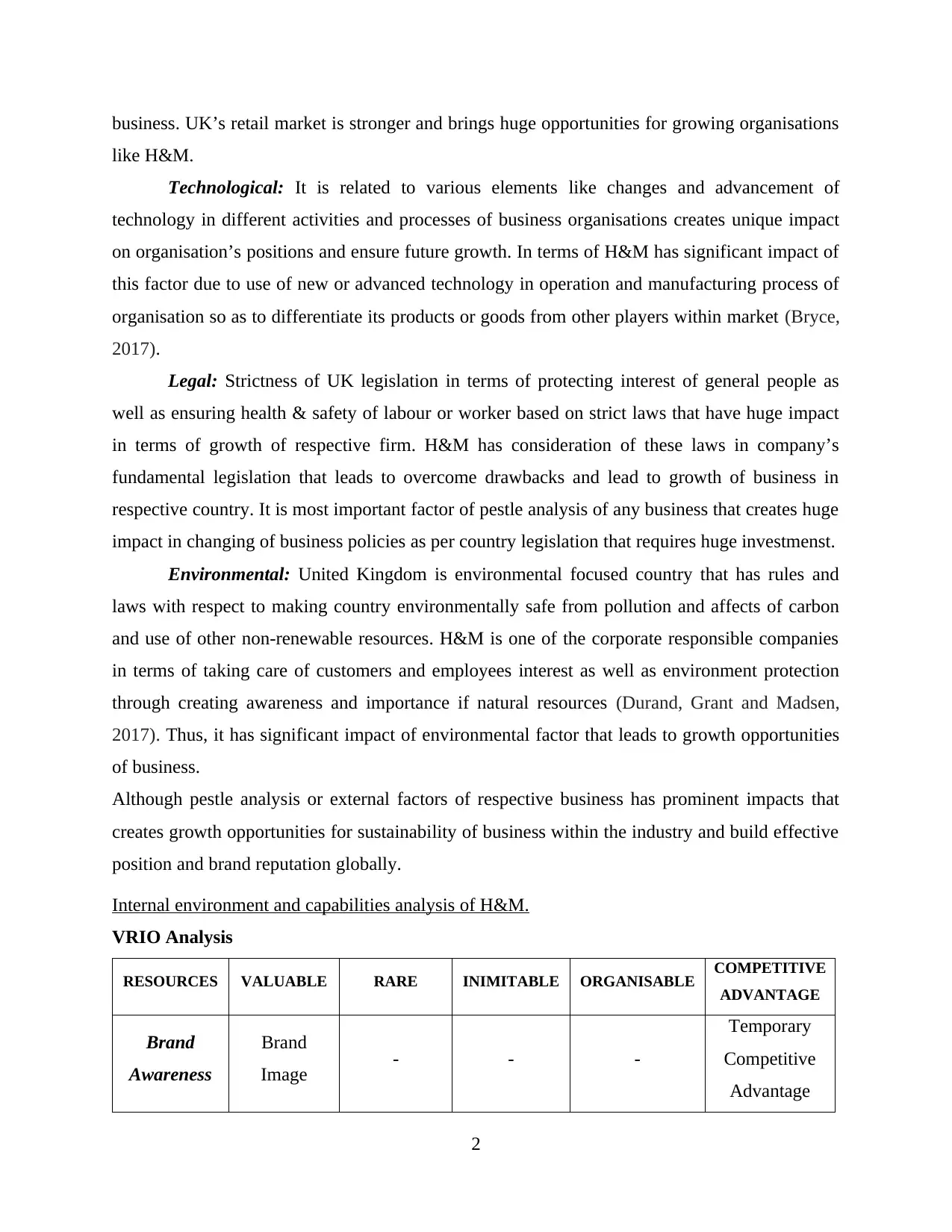
business. UK’s retail market is stronger and brings huge opportunities for growing organisations
like H&M.
Technological: It is related to various elements like changes and advancement of
technology in different activities and processes of business organisations creates unique impact
on organisation’s positions and ensure future growth. In terms of H&M has significant impact of
this factor due to use of new or advanced technology in operation and manufacturing process of
organisation so as to differentiate its products or goods from other players within market (Bryce,
2017).
Legal: Strictness of UK legislation in terms of protecting interest of general people as
well as ensuring health & safety of labour or worker based on strict laws that have huge impact
in terms of growth of respective firm. H&M has consideration of these laws in company’s
fundamental legislation that leads to overcome drawbacks and lead to growth of business in
respective country. It is most important factor of pestle analysis of any business that creates huge
impact in changing of business policies as per country legislation that requires huge investmenst.
Environmental: United Kingdom is environmental focused country that has rules and
laws with respect to making country environmentally safe from pollution and affects of carbon
and use of other non-renewable resources. H&M is one of the corporate responsible companies
in terms of taking care of customers and employees interest as well as environment protection
through creating awareness and importance if natural resources (Durand, Grant and Madsen,
2017). Thus, it has significant impact of environmental factor that leads to growth opportunities
of business.
Although pestle analysis or external factors of respective business has prominent impacts that
creates growth opportunities for sustainability of business within the industry and build effective
position and brand reputation globally.
Internal environment and capabilities analysis of H&M.
VRIO Analysis
RESOURCES VALUABLE RARE INIMITABLE ORGANISABLE COMPETITIVE
ADVANTAGE
Brand
Awareness
Brand
Image - - -
Temporary
Competitive
Advantage
2
like H&M.
Technological: It is related to various elements like changes and advancement of
technology in different activities and processes of business organisations creates unique impact
on organisation’s positions and ensure future growth. In terms of H&M has significant impact of
this factor due to use of new or advanced technology in operation and manufacturing process of
organisation so as to differentiate its products or goods from other players within market (Bryce,
2017).
Legal: Strictness of UK legislation in terms of protecting interest of general people as
well as ensuring health & safety of labour or worker based on strict laws that have huge impact
in terms of growth of respective firm. H&M has consideration of these laws in company’s
fundamental legislation that leads to overcome drawbacks and lead to growth of business in
respective country. It is most important factor of pestle analysis of any business that creates huge
impact in changing of business policies as per country legislation that requires huge investmenst.
Environmental: United Kingdom is environmental focused country that has rules and
laws with respect to making country environmentally safe from pollution and affects of carbon
and use of other non-renewable resources. H&M is one of the corporate responsible companies
in terms of taking care of customers and employees interest as well as environment protection
through creating awareness and importance if natural resources (Durand, Grant and Madsen,
2017). Thus, it has significant impact of environmental factor that leads to growth opportunities
of business.
Although pestle analysis or external factors of respective business has prominent impacts that
creates growth opportunities for sustainability of business within the industry and build effective
position and brand reputation globally.
Internal environment and capabilities analysis of H&M.
VRIO Analysis
RESOURCES VALUABLE RARE INIMITABLE ORGANISABLE COMPETITIVE
ADVANTAGE
Brand
Awareness
Brand
Image - - -
Temporary
Competitive
Advantage
2
Secure Best Marks with AI Grader
Need help grading? Try our AI Grader for instant feedback on your assignments.
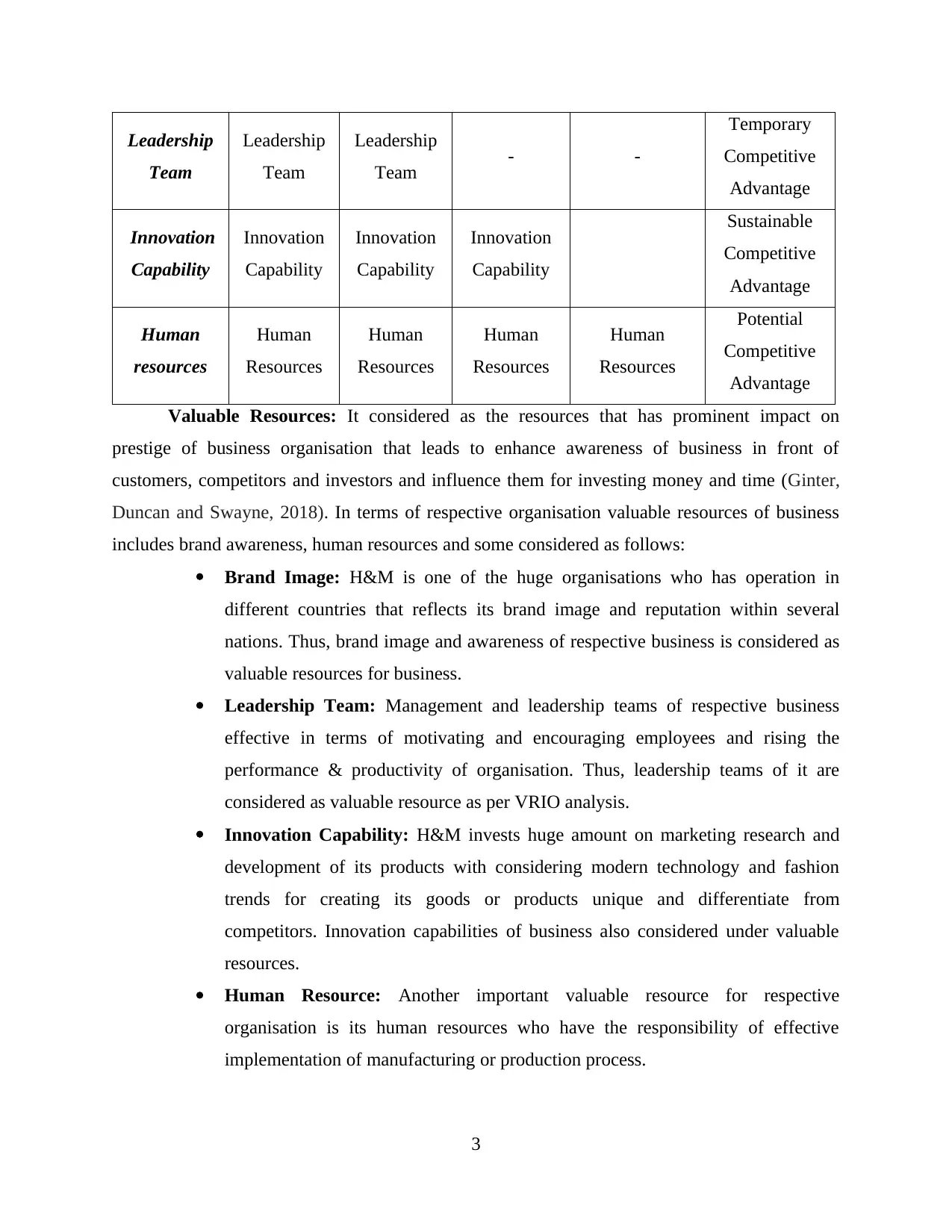
Leadership
Team
Leadership
Team
Leadership
Team - -
Temporary
Competitive
Advantage
Innovation
Capability
Innovation
Capability
Innovation
Capability
Innovation
Capability
Sustainable
Competitive
Advantage
Human
resources
Human
Resources
Human
Resources
Human
Resources
Human
Resources
Potential
Competitive
Advantage
Valuable Resources: It considered as the resources that has prominent impact on
prestige of business organisation that leads to enhance awareness of business in front of
customers, competitors and investors and influence them for investing money and time (Ginter,
Duncan and Swayne, 2018). In terms of respective organisation valuable resources of business
includes brand awareness, human resources and some considered as follows:
Brand Image: H&M is one of the huge organisations who has operation in
different countries that reflects its brand image and reputation within several
nations. Thus, brand image and awareness of respective business is considered as
valuable resources for business.
Leadership Team: Management and leadership teams of respective business
effective in terms of motivating and encouraging employees and rising the
performance & productivity of organisation. Thus, leadership teams of it are
considered as valuable resource as per VRIO analysis.
Innovation Capability: H&M invests huge amount on marketing research and
development of its products with considering modern technology and fashion
trends for creating its goods or products unique and differentiate from
competitors. Innovation capabilities of business also considered under valuable
resources.
Human Resource: Another important valuable resource for respective
organisation is its human resources who have the responsibility of effective
implementation of manufacturing or production process.
3
Team
Leadership
Team
Leadership
Team - -
Temporary
Competitive
Advantage
Innovation
Capability
Innovation
Capability
Innovation
Capability
Innovation
Capability
Sustainable
Competitive
Advantage
Human
resources
Human
Resources
Human
Resources
Human
Resources
Human
Resources
Potential
Competitive
Advantage
Valuable Resources: It considered as the resources that has prominent impact on
prestige of business organisation that leads to enhance awareness of business in front of
customers, competitors and investors and influence them for investing money and time (Ginter,
Duncan and Swayne, 2018). In terms of respective organisation valuable resources of business
includes brand awareness, human resources and some considered as follows:
Brand Image: H&M is one of the huge organisations who has operation in
different countries that reflects its brand image and reputation within several
nations. Thus, brand image and awareness of respective business is considered as
valuable resources for business.
Leadership Team: Management and leadership teams of respective business
effective in terms of motivating and encouraging employees and rising the
performance & productivity of organisation. Thus, leadership teams of it are
considered as valuable resource as per VRIO analysis.
Innovation Capability: H&M invests huge amount on marketing research and
development of its products with considering modern technology and fashion
trends for creating its goods or products unique and differentiate from
competitors. Innovation capabilities of business also considered under valuable
resources.
Human Resource: Another important valuable resource for respective
organisation is its human resources who have the responsibility of effective
implementation of manufacturing or production process.
3
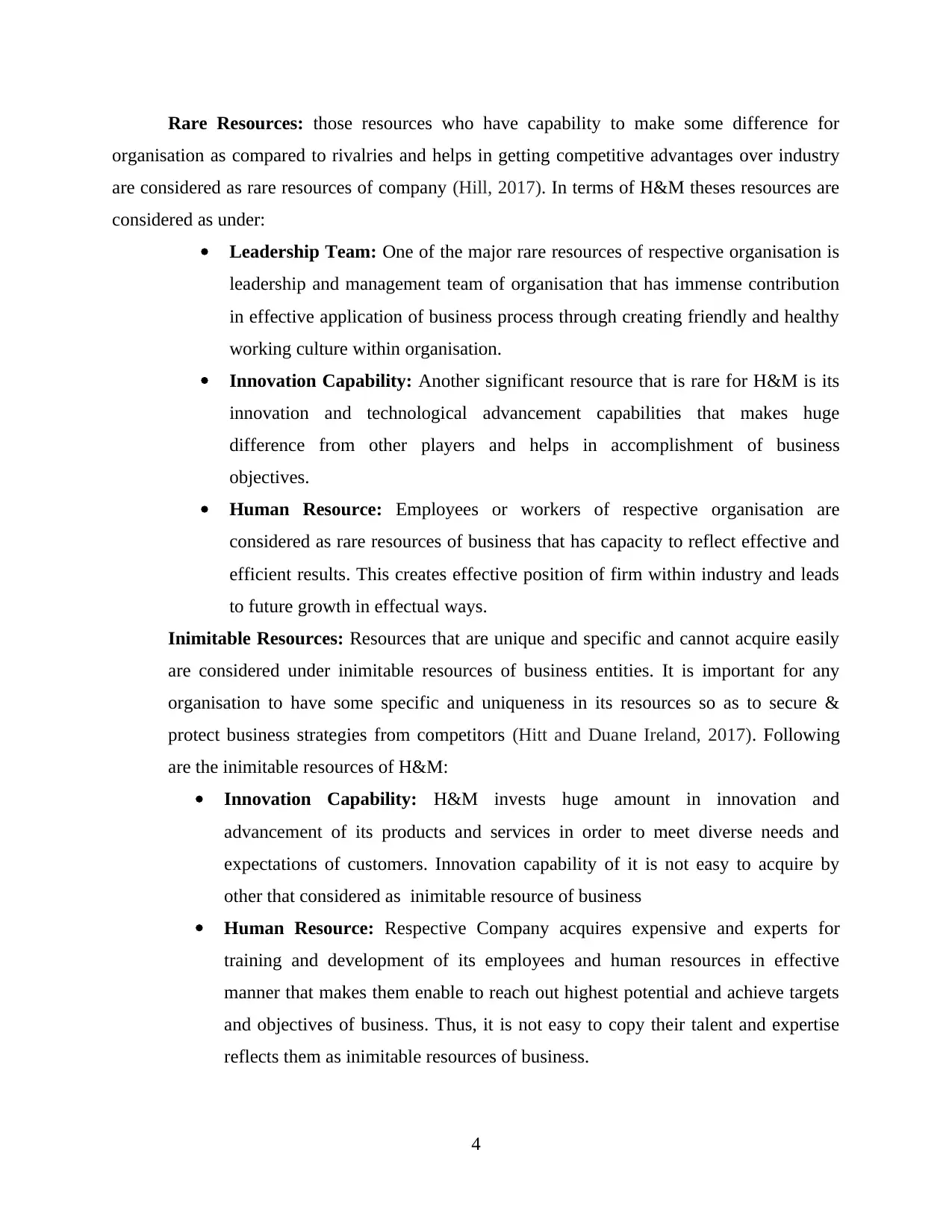
Rare Resources: those resources who have capability to make some difference for
organisation as compared to rivalries and helps in getting competitive advantages over industry
are considered as rare resources of company (Hill, 2017). In terms of H&M theses resources are
considered as under:
Leadership Team: One of the major rare resources of respective organisation is
leadership and management team of organisation that has immense contribution
in effective application of business process through creating friendly and healthy
working culture within organisation.
Innovation Capability: Another significant resource that is rare for H&M is its
innovation and technological advancement capabilities that makes huge
difference from other players and helps in accomplishment of business
objectives.
Human Resource: Employees or workers of respective organisation are
considered as rare resources of business that has capacity to reflect effective and
efficient results. This creates effective position of firm within industry and leads
to future growth in effectual ways.
Inimitable Resources: Resources that are unique and specific and cannot acquire easily
are considered under inimitable resources of business entities. It is important for any
organisation to have some specific and uniqueness in its resources so as to secure &
protect business strategies from competitors (Hitt and Duane Ireland, 2017). Following
are the inimitable resources of H&M:
Innovation Capability: H&M invests huge amount in innovation and
advancement of its products and services in order to meet diverse needs and
expectations of customers. Innovation capability of it is not easy to acquire by
other that considered as inimitable resource of business
Human Resource: Respective Company acquires expensive and experts for
training and development of its employees and human resources in effective
manner that makes them enable to reach out highest potential and achieve targets
and objectives of business. Thus, it is not easy to copy their talent and expertise
reflects them as inimitable resources of business.
4
organisation as compared to rivalries and helps in getting competitive advantages over industry
are considered as rare resources of company (Hill, 2017). In terms of H&M theses resources are
considered as under:
Leadership Team: One of the major rare resources of respective organisation is
leadership and management team of organisation that has immense contribution
in effective application of business process through creating friendly and healthy
working culture within organisation.
Innovation Capability: Another significant resource that is rare for H&M is its
innovation and technological advancement capabilities that makes huge
difference from other players and helps in accomplishment of business
objectives.
Human Resource: Employees or workers of respective organisation are
considered as rare resources of business that has capacity to reflect effective and
efficient results. This creates effective position of firm within industry and leads
to future growth in effectual ways.
Inimitable Resources: Resources that are unique and specific and cannot acquire easily
are considered under inimitable resources of business entities. It is important for any
organisation to have some specific and uniqueness in its resources so as to secure &
protect business strategies from competitors (Hitt and Duane Ireland, 2017). Following
are the inimitable resources of H&M:
Innovation Capability: H&M invests huge amount in innovation and
advancement of its products and services in order to meet diverse needs and
expectations of customers. Innovation capability of it is not easy to acquire by
other that considered as inimitable resource of business
Human Resource: Respective Company acquires expensive and experts for
training and development of its employees and human resources in effective
manner that makes them enable to reach out highest potential and achieve targets
and objectives of business. Thus, it is not easy to copy their talent and expertise
reflects them as inimitable resources of business.
4
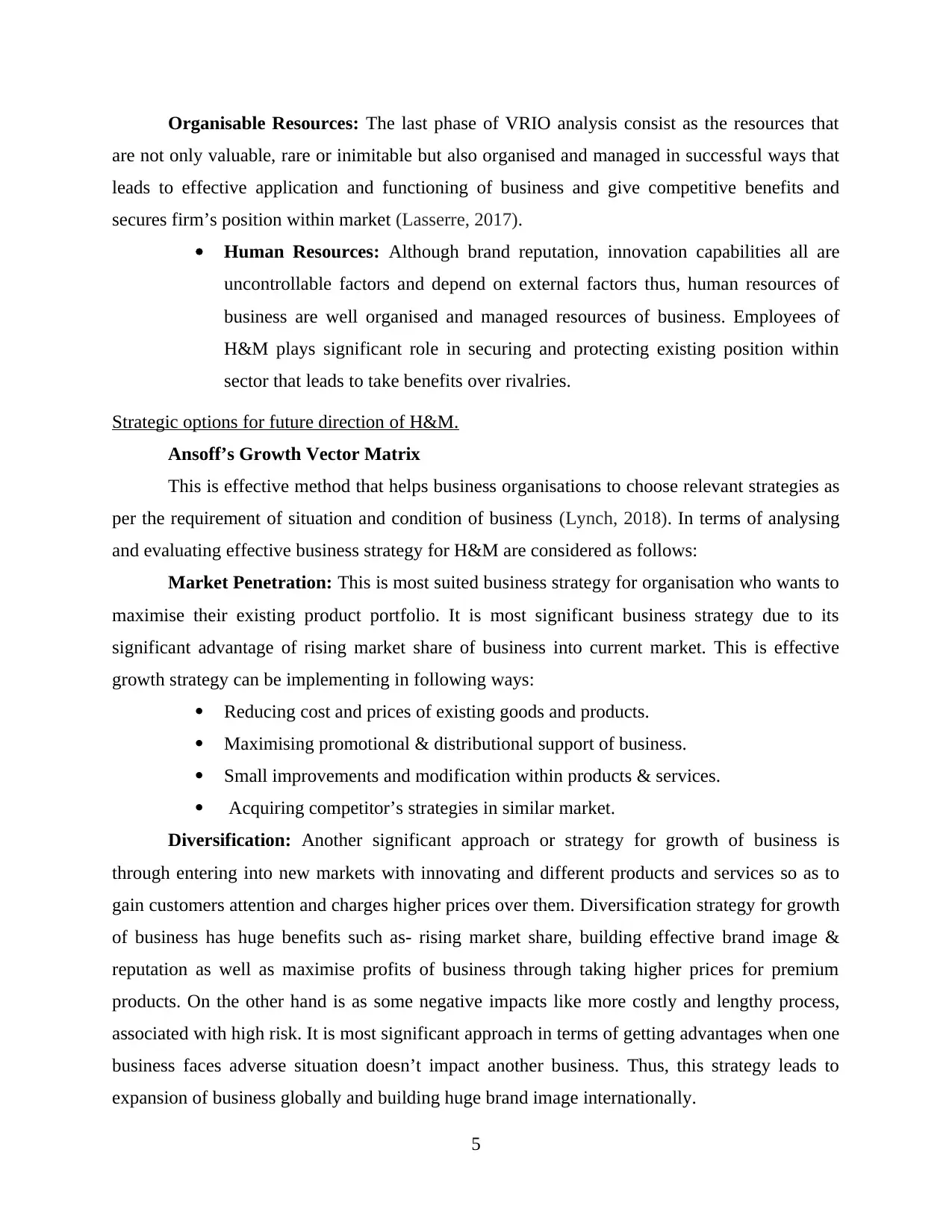
Organisable Resources: The last phase of VRIO analysis consist as the resources that
are not only valuable, rare or inimitable but also organised and managed in successful ways that
leads to effective application and functioning of business and give competitive benefits and
secures firm’s position within market (Lasserre, 2017).
Human Resources: Although brand reputation, innovation capabilities all are
uncontrollable factors and depend on external factors thus, human resources of
business are well organised and managed resources of business. Employees of
H&M plays significant role in securing and protecting existing position within
sector that leads to take benefits over rivalries.
Strategic options for future direction of H&M.
Ansoff’s Growth Vector Matrix
This is effective method that helps business organisations to choose relevant strategies as
per the requirement of situation and condition of business (Lynch, 2018). In terms of analysing
and evaluating effective business strategy for H&M are considered as follows:
Market Penetration: This is most suited business strategy for organisation who wants to
maximise their existing product portfolio. It is most significant business strategy due to its
significant advantage of rising market share of business into current market. This is effective
growth strategy can be implementing in following ways:
Reducing cost and prices of existing goods and products.
Maximising promotional & distributional support of business.
Small improvements and modification within products & services.
Acquiring competitor’s strategies in similar market.
Diversification: Another significant approach or strategy for growth of business is
through entering into new markets with innovating and different products and services so as to
gain customers attention and charges higher prices over them. Diversification strategy for growth
of business has huge benefits such as- rising market share, building effective brand image &
reputation as well as maximise profits of business through taking higher prices for premium
products. On the other hand is as some negative impacts like more costly and lengthy process,
associated with high risk. It is most significant approach in terms of getting advantages when one
business faces adverse situation doesn’t impact another business. Thus, this strategy leads to
expansion of business globally and building huge brand image internationally.
5
are not only valuable, rare or inimitable but also organised and managed in successful ways that
leads to effective application and functioning of business and give competitive benefits and
secures firm’s position within market (Lasserre, 2017).
Human Resources: Although brand reputation, innovation capabilities all are
uncontrollable factors and depend on external factors thus, human resources of
business are well organised and managed resources of business. Employees of
H&M plays significant role in securing and protecting existing position within
sector that leads to take benefits over rivalries.
Strategic options for future direction of H&M.
Ansoff’s Growth Vector Matrix
This is effective method that helps business organisations to choose relevant strategies as
per the requirement of situation and condition of business (Lynch, 2018). In terms of analysing
and evaluating effective business strategy for H&M are considered as follows:
Market Penetration: This is most suited business strategy for organisation who wants to
maximise their existing product portfolio. It is most significant business strategy due to its
significant advantage of rising market share of business into current market. This is effective
growth strategy can be implementing in following ways:
Reducing cost and prices of existing goods and products.
Maximising promotional & distributional support of business.
Small improvements and modification within products & services.
Acquiring competitor’s strategies in similar market.
Diversification: Another significant approach or strategy for growth of business is
through entering into new markets with innovating and different products and services so as to
gain customers attention and charges higher prices over them. Diversification strategy for growth
of business has huge benefits such as- rising market share, building effective brand image &
reputation as well as maximise profits of business through taking higher prices for premium
products. On the other hand is as some negative impacts like more costly and lengthy process,
associated with high risk. It is most significant approach in terms of getting advantages when one
business faces adverse situation doesn’t impact another business. Thus, this strategy leads to
expansion of business globally and building huge brand image internationally.
5
Paraphrase This Document
Need a fresh take? Get an instant paraphrase of this document with our AI Paraphraser
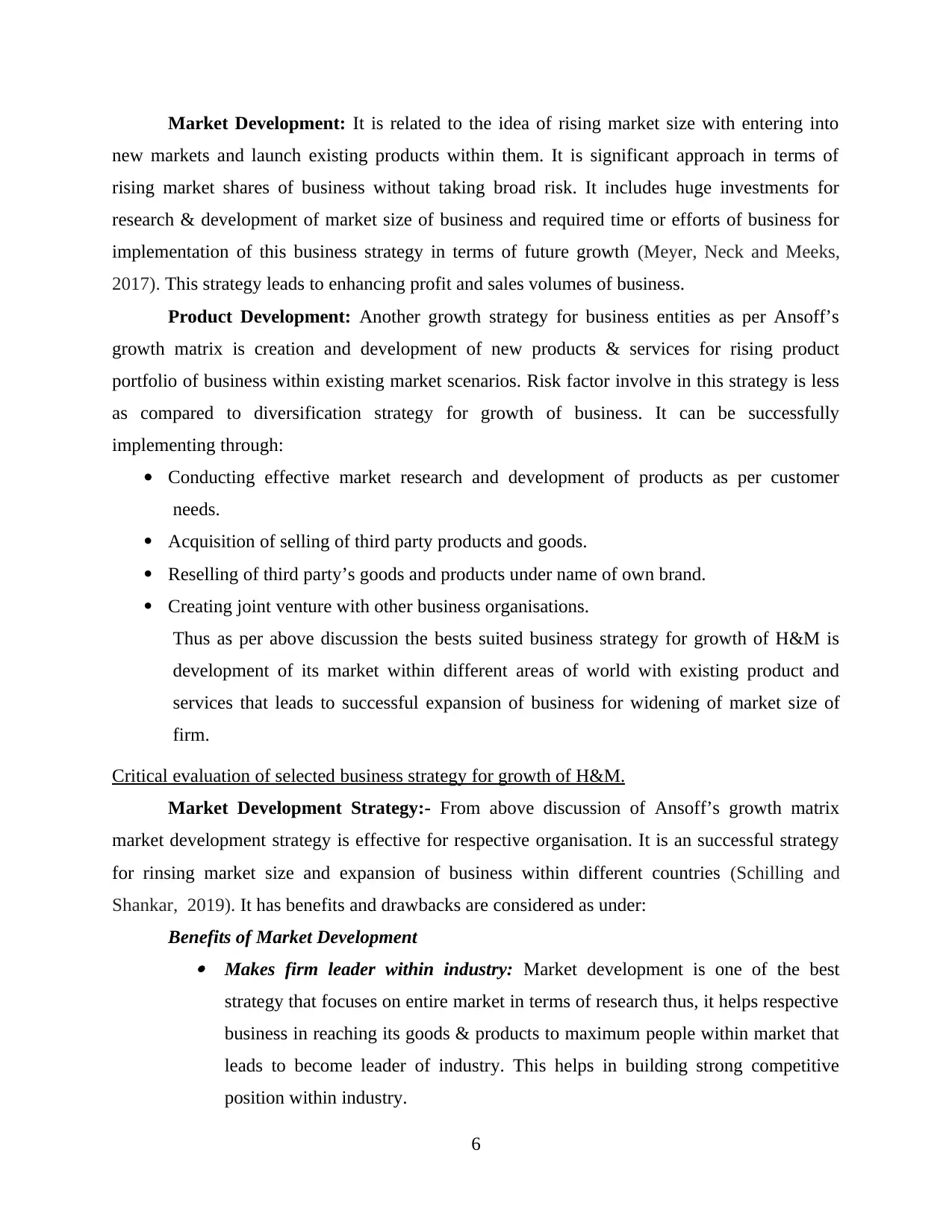
Market Development: It is related to the idea of rising market size with entering into
new markets and launch existing products within them. It is significant approach in terms of
rising market shares of business without taking broad risk. It includes huge investments for
research & development of market size of business and required time or efforts of business for
implementation of this business strategy in terms of future growth (Meyer, Neck and Meeks,
2017). This strategy leads to enhancing profit and sales volumes of business.
Product Development: Another growth strategy for business entities as per Ansoff’s
growth matrix is creation and development of new products & services for rising product
portfolio of business within existing market scenarios. Risk factor involve in this strategy is less
as compared to diversification strategy for growth of business. It can be successfully
implementing through:
Conducting effective market research and development of products as per customer
needs.
Acquisition of selling of third party products and goods.
Reselling of third party’s goods and products under name of own brand.
Creating joint venture with other business organisations.
Thus as per above discussion the bests suited business strategy for growth of H&M is
development of its market within different areas of world with existing product and
services that leads to successful expansion of business for widening of market size of
firm.
Critical evaluation of selected business strategy for growth of H&M.
Market Development Strategy:- From above discussion of Ansoff’s growth matrix
market development strategy is effective for respective organisation. It is an successful strategy
for rinsing market size and expansion of business within different countries (Schilling and
Shankar, 2019). It has benefits and drawbacks are considered as under:
Benefits of Market Development
Makes firm leader within industry: Market development is one of the best
strategy that focuses on entire market in terms of research thus, it helps respective
business in reaching its goods & products to maximum people within market that
leads to become leader of industry. This helps in building strong competitive
position within industry.
6
new markets and launch existing products within them. It is significant approach in terms of
rising market shares of business without taking broad risk. It includes huge investments for
research & development of market size of business and required time or efforts of business for
implementation of this business strategy in terms of future growth (Meyer, Neck and Meeks,
2017). This strategy leads to enhancing profit and sales volumes of business.
Product Development: Another growth strategy for business entities as per Ansoff’s
growth matrix is creation and development of new products & services for rising product
portfolio of business within existing market scenarios. Risk factor involve in this strategy is less
as compared to diversification strategy for growth of business. It can be successfully
implementing through:
Conducting effective market research and development of products as per customer
needs.
Acquisition of selling of third party products and goods.
Reselling of third party’s goods and products under name of own brand.
Creating joint venture with other business organisations.
Thus as per above discussion the bests suited business strategy for growth of H&M is
development of its market within different areas of world with existing product and
services that leads to successful expansion of business for widening of market size of
firm.
Critical evaluation of selected business strategy for growth of H&M.
Market Development Strategy:- From above discussion of Ansoff’s growth matrix
market development strategy is effective for respective organisation. It is an successful strategy
for rinsing market size and expansion of business within different countries (Schilling and
Shankar, 2019). It has benefits and drawbacks are considered as under:
Benefits of Market Development
Makes firm leader within industry: Market development is one of the best
strategy that focuses on entire market in terms of research thus, it helps respective
business in reaching its goods & products to maximum people within market that
leads to become leader of industry. This helps in building strong competitive
position within industry.
6
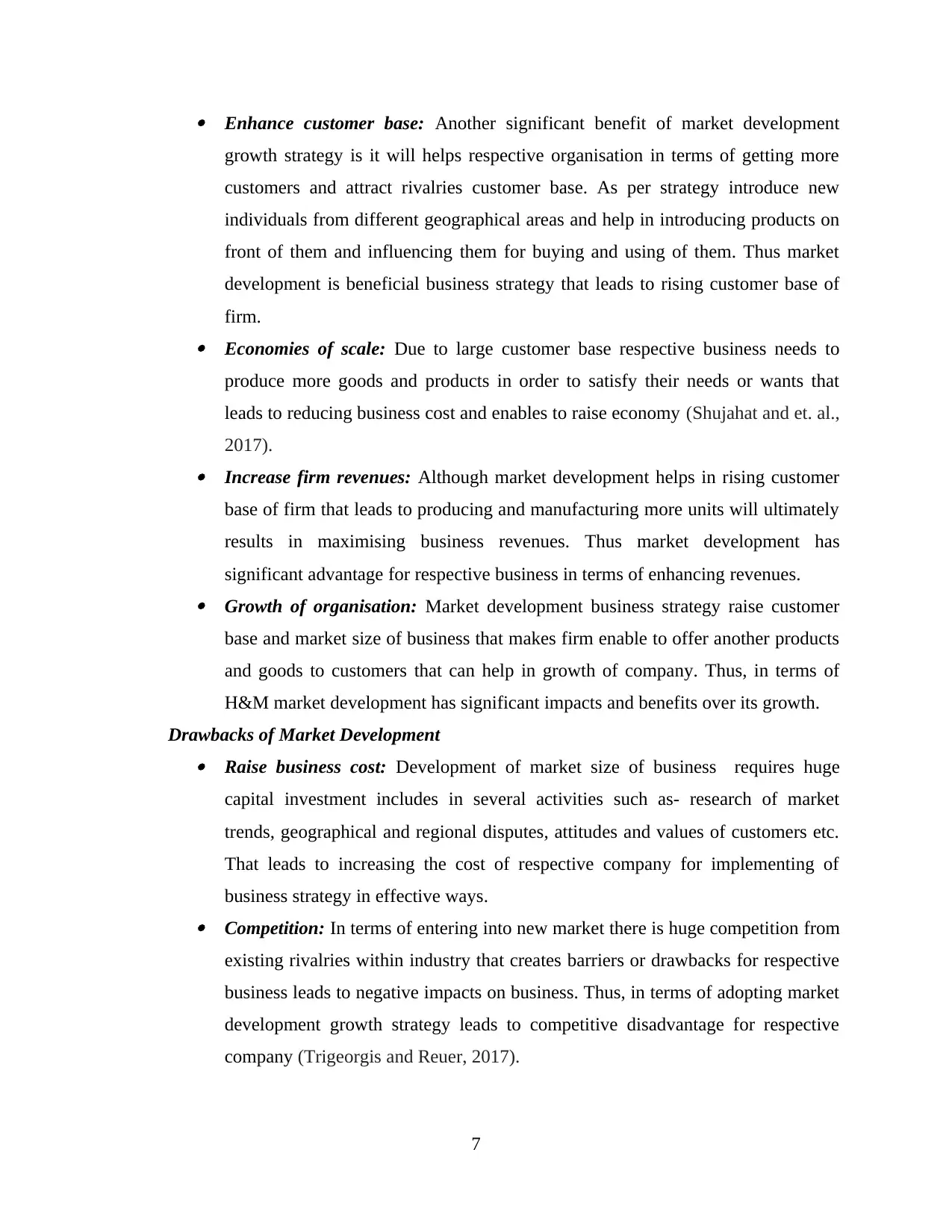
Enhance customer base: Another significant benefit of market development
growth strategy is it will helps respective organisation in terms of getting more
customers and attract rivalries customer base. As per strategy introduce new
individuals from different geographical areas and help in introducing products on
front of them and influencing them for buying and using of them. Thus market
development is beneficial business strategy that leads to rising customer base of
firm.
Economies of scale: Due to large customer base respective business needs to
produce more goods and products in order to satisfy their needs or wants that
leads to reducing business cost and enables to raise economy (Shujahat and et. al.,
2017).
Increase firm revenues: Although market development helps in rising customer
base of firm that leads to producing and manufacturing more units will ultimately
results in maximising business revenues. Thus market development has
significant advantage for respective business in terms of enhancing revenues.
Growth of organisation: Market development business strategy raise customer
base and market size of business that makes firm enable to offer another products
and goods to customers that can help in growth of company. Thus, in terms of
H&M market development has significant impacts and benefits over its growth.
Drawbacks of Market Development
Raise business cost: Development of market size of business requires huge
capital investment includes in several activities such as- research of market
trends, geographical and regional disputes, attitudes and values of customers etc.
That leads to increasing the cost of respective company for implementing of
business strategy in effective ways.
Competition: In terms of entering into new market there is huge competition from
existing rivalries within industry that creates barriers or drawbacks for respective
business leads to negative impacts on business. Thus, in terms of adopting market
development growth strategy leads to competitive disadvantage for respective
company (Trigeorgis and Reuer, 2017).
7
growth strategy is it will helps respective organisation in terms of getting more
customers and attract rivalries customer base. As per strategy introduce new
individuals from different geographical areas and help in introducing products on
front of them and influencing them for buying and using of them. Thus market
development is beneficial business strategy that leads to rising customer base of
firm.
Economies of scale: Due to large customer base respective business needs to
produce more goods and products in order to satisfy their needs or wants that
leads to reducing business cost and enables to raise economy (Shujahat and et. al.,
2017).
Increase firm revenues: Although market development helps in rising customer
base of firm that leads to producing and manufacturing more units will ultimately
results in maximising business revenues. Thus market development has
significant advantage for respective business in terms of enhancing revenues.
Growth of organisation: Market development business strategy raise customer
base and market size of business that makes firm enable to offer another products
and goods to customers that can help in growth of company. Thus, in terms of
H&M market development has significant impacts and benefits over its growth.
Drawbacks of Market Development
Raise business cost: Development of market size of business requires huge
capital investment includes in several activities such as- research of market
trends, geographical and regional disputes, attitudes and values of customers etc.
That leads to increasing the cost of respective company for implementing of
business strategy in effective ways.
Competition: In terms of entering into new market there is huge competition from
existing rivalries within industry that creates barriers or drawbacks for respective
business leads to negative impacts on business. Thus, in terms of adopting market
development growth strategy leads to competitive disadvantage for respective
company (Trigeorgis and Reuer, 2017).
7
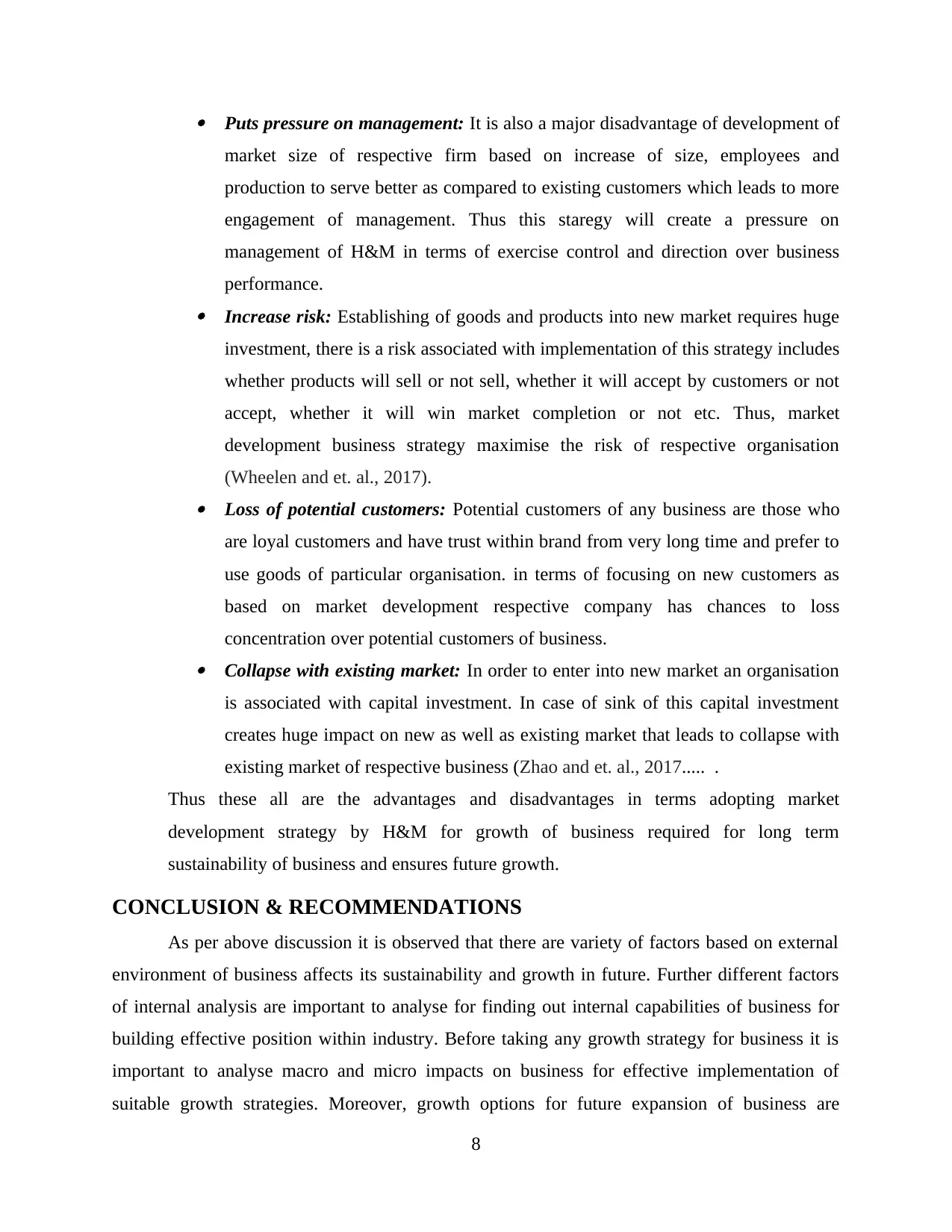
Puts pressure on management: It is also a major disadvantage of development of
market size of respective firm based on increase of size, employees and
production to serve better as compared to existing customers which leads to more
engagement of management. Thus this staregy will create a pressure on
management of H&M in terms of exercise control and direction over business
performance.
Increase risk: Establishing of goods and products into new market requires huge
investment, there is a risk associated with implementation of this strategy includes
whether products will sell or not sell, whether it will accept by customers or not
accept, whether it will win market completion or not etc. Thus, market
development business strategy maximise the risk of respective organisation
(Wheelen and et. al., 2017).
Loss of potential customers: Potential customers of any business are those who
are loyal customers and have trust within brand from very long time and prefer to
use goods of particular organisation. in terms of focusing on new customers as
based on market development respective company has chances to loss
concentration over potential customers of business.
Collapse with existing market: In order to enter into new market an organisation
is associated with capital investment. In case of sink of this capital investment
creates huge impact on new as well as existing market that leads to collapse with
existing market of respective business (Zhao and et. al., 2017..... .
Thus these all are the advantages and disadvantages in terms adopting market
development strategy by H&M for growth of business required for long term
sustainability of business and ensures future growth.
CONCLUSION & RECOMMENDATIONS
As per above discussion it is observed that there are variety of factors based on external
environment of business affects its sustainability and growth in future. Further different factors
of internal analysis are important to analyse for finding out internal capabilities of business for
building effective position within industry. Before taking any growth strategy for business it is
important to analyse macro and micro impacts on business for effective implementation of
suitable growth strategies. Moreover, growth options for future expansion of business are
8
market size of respective firm based on increase of size, employees and
production to serve better as compared to existing customers which leads to more
engagement of management. Thus this staregy will create a pressure on
management of H&M in terms of exercise control and direction over business
performance.
Increase risk: Establishing of goods and products into new market requires huge
investment, there is a risk associated with implementation of this strategy includes
whether products will sell or not sell, whether it will accept by customers or not
accept, whether it will win market completion or not etc. Thus, market
development business strategy maximise the risk of respective organisation
(Wheelen and et. al., 2017).
Loss of potential customers: Potential customers of any business are those who
are loyal customers and have trust within brand from very long time and prefer to
use goods of particular organisation. in terms of focusing on new customers as
based on market development respective company has chances to loss
concentration over potential customers of business.
Collapse with existing market: In order to enter into new market an organisation
is associated with capital investment. In case of sink of this capital investment
creates huge impact on new as well as existing market that leads to collapse with
existing market of respective business (Zhao and et. al., 2017..... .
Thus these all are the advantages and disadvantages in terms adopting market
development strategy by H&M for growth of business required for long term
sustainability of business and ensures future growth.
CONCLUSION & RECOMMENDATIONS
As per above discussion it is observed that there are variety of factors based on external
environment of business affects its sustainability and growth in future. Further different factors
of internal analysis are important to analyse for finding out internal capabilities of business for
building effective position within industry. Before taking any growth strategy for business it is
important to analyse macro and micro impacts on business for effective implementation of
suitable growth strategies. Moreover, growth options for future expansion of business are
8
Secure Best Marks with AI Grader
Need help grading? Try our AI Grader for instant feedback on your assignments.
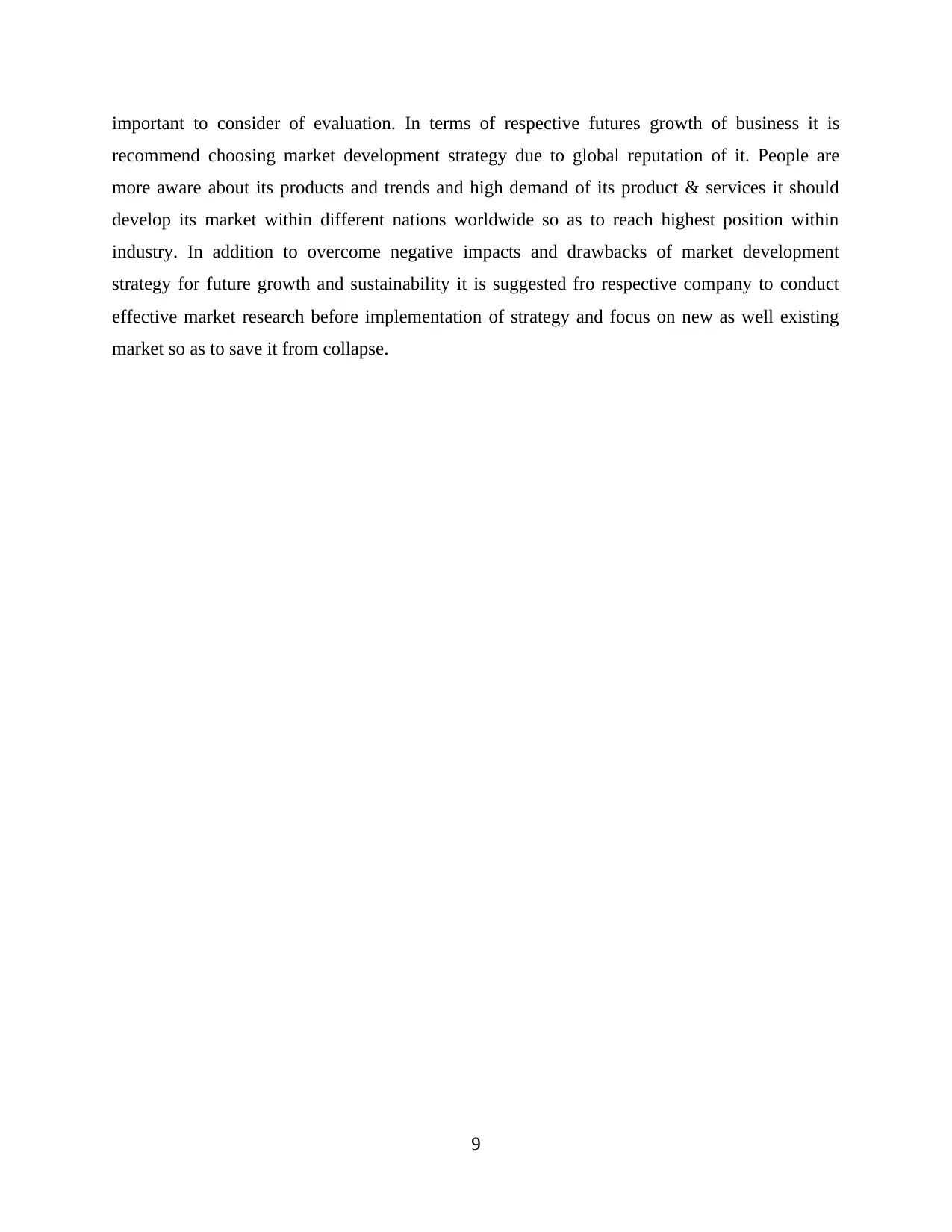
important to consider of evaluation. In terms of respective futures growth of business it is
recommend choosing market development strategy due to global reputation of it. People are
more aware about its products and trends and high demand of its product & services it should
develop its market within different nations worldwide so as to reach highest position within
industry. In addition to overcome negative impacts and drawbacks of market development
strategy for future growth and sustainability it is suggested fro respective company to conduct
effective market research before implementation of strategy and focus on new as well existing
market so as to save it from collapse.
9
recommend choosing market development strategy due to global reputation of it. People are
more aware about its products and trends and high demand of its product & services it should
develop its market within different nations worldwide so as to reach highest position within
industry. In addition to overcome negative impacts and drawbacks of market development
strategy for future growth and sustainability it is suggested fro respective company to conduct
effective market research before implementation of strategy and focus on new as well existing
market so as to save it from collapse.
9
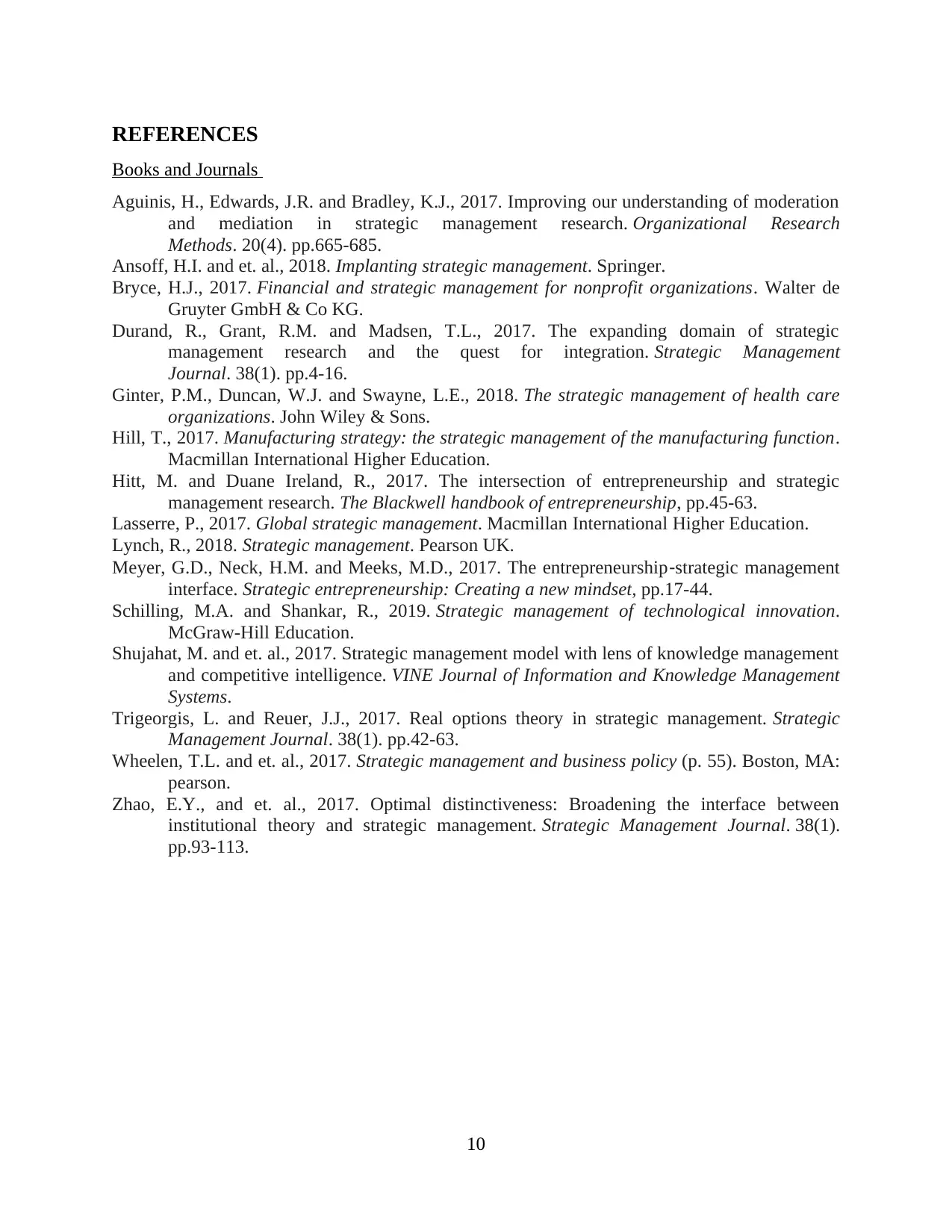
REFERENCES
Books and Journals
Aguinis, H., Edwards, J.R. and Bradley, K.J., 2017. Improving our understanding of moderation
and mediation in strategic management research. Organizational Research
Methods. 20(4). pp.665-685.
Ansoff, H.I. and et. al., 2018. Implanting strategic management. Springer.
Bryce, H.J., 2017. Financial and strategic management for nonprofit organizations. Walter de
Gruyter GmbH & Co KG.
Durand, R., Grant, R.M. and Madsen, T.L., 2017. The expanding domain of strategic
management research and the quest for integration. Strategic Management
Journal. 38(1). pp.4-16.
Ginter, P.M., Duncan, W.J. and Swayne, L.E., 2018. The strategic management of health care
organizations. John Wiley & Sons.
Hill, T., 2017. Manufacturing strategy: the strategic management of the manufacturing function.
Macmillan International Higher Education.
Hitt, M. and Duane Ireland, R., 2017. The intersection of entrepreneurship and strategic
management research. The Blackwell handbook of entrepreneurship, pp.45-63.
Lasserre, P., 2017. Global strategic management. Macmillan International Higher Education.
Lynch, R., 2018. Strategic management. Pearson UK.
Meyer, G.D., Neck, H.M. and Meeks, M.D., 2017. The entrepreneurship‐strategic management
interface. Strategic entrepreneurship: Creating a new mindset, pp.17-44.
Schilling, M.A. and Shankar, R., 2019. Strategic management of technological innovation.
McGraw-Hill Education.
Shujahat, M. and et. al., 2017. Strategic management model with lens of knowledge management
and competitive intelligence. VINE Journal of Information and Knowledge Management
Systems.
Trigeorgis, L. and Reuer, J.J., 2017. Real options theory in strategic management. Strategic
Management Journal. 38(1). pp.42-63.
Wheelen, T.L. and et. al., 2017. Strategic management and business policy (p. 55). Boston, MA:
pearson.
Zhao, E.Y., and et. al., 2017. Optimal distinctiveness: Broadening the interface between
institutional theory and strategic management. Strategic Management Journal. 38(1).
pp.93-113.
10
Books and Journals
Aguinis, H., Edwards, J.R. and Bradley, K.J., 2017. Improving our understanding of moderation
and mediation in strategic management research. Organizational Research
Methods. 20(4). pp.665-685.
Ansoff, H.I. and et. al., 2018. Implanting strategic management. Springer.
Bryce, H.J., 2017. Financial and strategic management for nonprofit organizations. Walter de
Gruyter GmbH & Co KG.
Durand, R., Grant, R.M. and Madsen, T.L., 2017. The expanding domain of strategic
management research and the quest for integration. Strategic Management
Journal. 38(1). pp.4-16.
Ginter, P.M., Duncan, W.J. and Swayne, L.E., 2018. The strategic management of health care
organizations. John Wiley & Sons.
Hill, T., 2017. Manufacturing strategy: the strategic management of the manufacturing function.
Macmillan International Higher Education.
Hitt, M. and Duane Ireland, R., 2017. The intersection of entrepreneurship and strategic
management research. The Blackwell handbook of entrepreneurship, pp.45-63.
Lasserre, P., 2017. Global strategic management. Macmillan International Higher Education.
Lynch, R., 2018. Strategic management. Pearson UK.
Meyer, G.D., Neck, H.M. and Meeks, M.D., 2017. The entrepreneurship‐strategic management
interface. Strategic entrepreneurship: Creating a new mindset, pp.17-44.
Schilling, M.A. and Shankar, R., 2019. Strategic management of technological innovation.
McGraw-Hill Education.
Shujahat, M. and et. al., 2017. Strategic management model with lens of knowledge management
and competitive intelligence. VINE Journal of Information and Knowledge Management
Systems.
Trigeorgis, L. and Reuer, J.J., 2017. Real options theory in strategic management. Strategic
Management Journal. 38(1). pp.42-63.
Wheelen, T.L. and et. al., 2017. Strategic management and business policy (p. 55). Boston, MA:
pearson.
Zhao, E.Y., and et. al., 2017. Optimal distinctiveness: Broadening the interface between
institutional theory and strategic management. Strategic Management Journal. 38(1).
pp.93-113.
10

11
1 out of 13
Related Documents
Your All-in-One AI-Powered Toolkit for Academic Success.
+13062052269
info@desklib.com
Available 24*7 on WhatsApp / Email
![[object Object]](/_next/static/media/star-bottom.7253800d.svg)
Unlock your academic potential
© 2024 | Zucol Services PVT LTD | All rights reserved.





